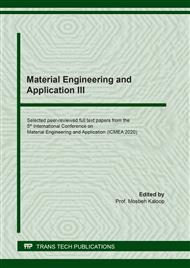p.25
p.31
p.39
p.45
p.51
p.57
p.67
p.77
p.83
Feasibility of Nagan Raya Power Plantation Waste as Base Material on Geopolymer System
Abstract:
The material of FA Nagan Raya (FANR) is the alternative base material in geopolymer generated from the power plantation, Nagan Raya, Acheh, Indonesia. It was recorded that the volume of FANR material is abundant in the landfill so that it impacted on the environment. It was due to there was no investigation to evaluate the waste of FANR to be a material in the concrete. This study interested to evaluate the material of FANR to be a base material in the geopolymer referring to the analyses of XRF, XRD, SEM, FTIR, and TGA. The results showed that the material of FANR was rich in Si and Al content that contributed to the mechanical properties. While the chemical content of Ca contributed to the setting time in the geopolymer system. The XRD analysis showed that the FANR particle and binder of a geopolymer were categorized as the crystalline material. It was supported by the FTIR analysis that showed the good chemical bond of Si-O-Si and Si-O-Al. The SEM analysis showed that the particle shape of FANR was a sphere with the misty surface. This particle shape caused the absorption of a more alkaline solution to maintain the workability in the fresh geopolymer. It was supported by the analysis of TGA that showed more water in the FANR geopolymer binder. It concluded that the material of FANR is eligible to be used as the base material in the geopolymer system.
Info:
Periodical:
Pages:
51-56
Citation:
Online since:
February 2021
Authors:
Keywords:
Price:
Сopyright:
© 2021 Trans Tech Publications Ltd. All Rights Reserved
Share:
Citation:


